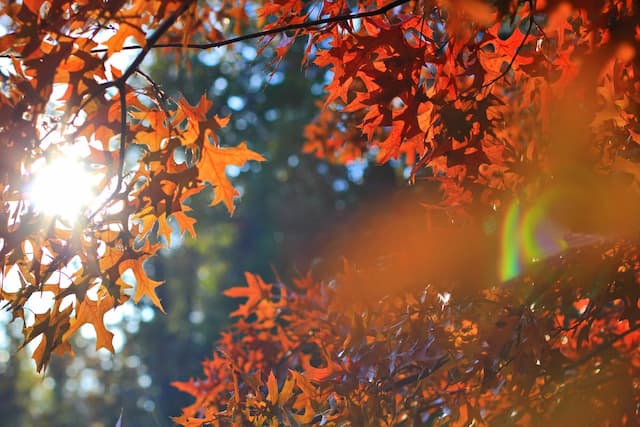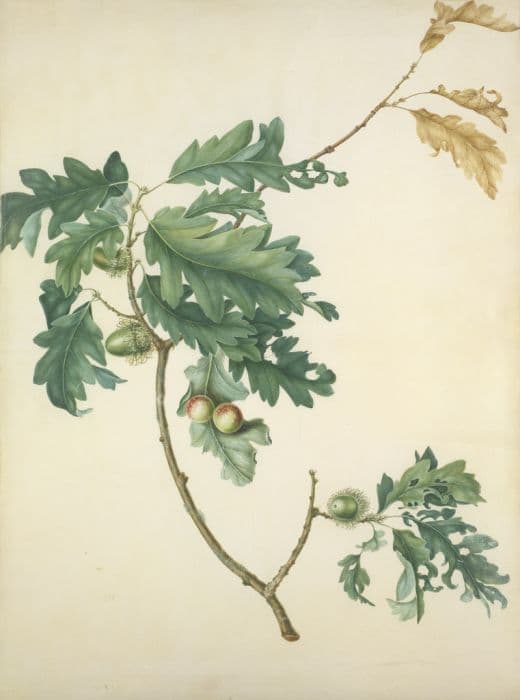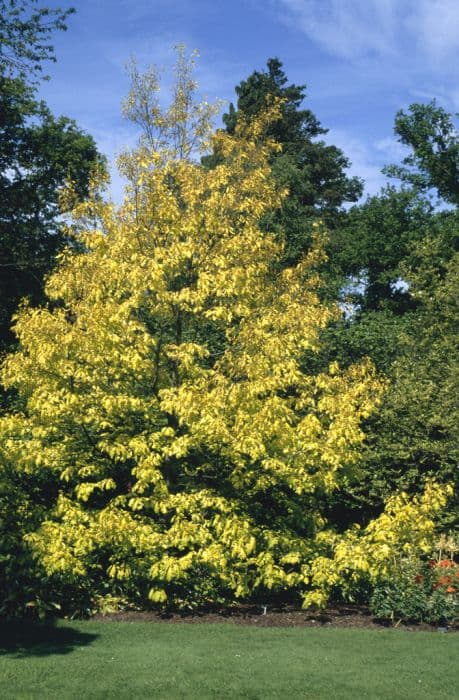Northern Pin Oak Quercus ellipsoidalis 'Hemelrijk'

ABOUT
The Quercus ellipsoidalis 'Hemelrijk', commonly known as the Northern Pin Oak or Hill's Oak, is a deciduous tree that is noted for its attractive foliage and bark. This tree typically has a rounded to oval crown with a somewhat open, irregular growth habit that gives it a picturesque appearance throughout the year. Its leaves are deeply lobed, somewhat resembling the fingers of a hand. They have pointed tips and are sharply toothed along the edges, adding a fine texture to the tree's silhouette. In spring, the leaves emerge with a reddish tinge before transitioning to a shiny, dark green on the upper surface, while the undersides tend to be a lighter green. Come fall, the foliage puts on a striking display, changing to bright shades of red and orange, creating a warm and vibrant canopy. The bark of the Northern Pin Oak is also an appealing feature. It is dark, ranging from nearly black to dark gray, and often deeply furrowed, adding a rugged and textured look to the landscape even in winter when the tree is leafless. Additionally, the tree produces acorns that are typical of oaks. They are usually small and rounded, with a tough outer shell that protects the seed inside. These acorns are a valuable food source for wildlife. Overall, the Northern Pin Oak 'Hemelrijk' is a picturesque tree with a strong seasonal interest, from the unfurling of its reddish leaves in spring to the majestic fall colors and the rugged winter bark texture.
About this plant
 Names
NamesFamily
Fagaceae
Synonyms
Northern Pin Oak, Hill's Oak, Jack Oak
Common names
Quercus ellipsoidalis 'Hemelrijk'.
 Toxicity
ToxicityTo humans
The Quercus ellipsoidalis 'Hemelrijk', commonly known as the Northern Pin Oak, is not traditionally viewed as a toxic plant to humans. However, eating large quantities of acorns or young shoots and leaves—especially from red oak species, which includes the Northern Pin Oak—can potentially cause gastrointestinal distress due to the presence of tannins. Symptoms may include stomach pain, nausea, vomiting, and diarrhea. Generally, incidents of poisoning are rare as these parts are not commonly consumed by humans.
To pets
The Northern Pin Oak, when ingested by pets, can be potentially harmful. Acorns and leaves contain tannins, which can cause gastrointestinal upset in animals such as dogs and cats, although they are more likely to be a risk to livestock. Symptoms of poisoning in pets can include vomiting, diarrhea, abdominal discomfort, and constipation. In rare cases or with large ingestions, more serious complications such as kidney damage or gastrointestinal obstruction could occur.
 Characteristics
CharacteristicsLife cycle
Perennials
Foliage type
Deciduous
Color of leaves
Green
Height
40 60 (12 19 meters)
Spread
40 60 (12 19 meters)
Plant type
Tree
Hardiness zones
4
Native area
North America
Benefits
 General Benefits
General Benefits- Shade provider: Offers a broad canopy that can create cool, shaded areas in landscapes.
- Wildlife habitat: Serves as a habitat and food source for various fauna, including birds and squirrels.
- Erosion control: Its extensive root system can help stabilize soil and reduce erosion.
- Aesthetic appeal: Adds visual interest to parks and gardens, especially with its distinctive fall coloration.
- Drought resistance: Once established, it can tolerate periods of drought, making it suitable for a variety of climates.
- Longevity: Can live for many years, providing long-term benefits to the environment.
- Carbon sequestration: Like other trees, it captures atmospheric carbon dioxide, contributing to climate regulation.
 Medical Properties
Medical PropertiesThis plant is not used for medical purposes.
 Air-purifying Qualities
Air-purifying QualitiesThis plant is not specifically known for air purifying qualities.
 Other Uses
Other Uses- Woodworking and Carpentry: The Northern Pin Oak's hardwood is appreciated for furniture making, flooring, and detailed joinery.
- Landscape Highlight: Given its distinctive form and foliage, the Northern Pin Oak is often planted as a decorative feature in parks and large gardens.
- Wildlife Habitat: The tree provides shelter and nesting sites for various bird species and small mammals within its branches.
- Soil Stabilization: With its deep root system, the tree is used to prevent soil erosion, particularly on slopes and in sandy areas.
- Shade Provider: Northern Pin Oak is planted in urban environments to create shaded areas, reducing the heat island effect and making outdoor spaces more comfortable.
- Dye Production: The tree's bark can be used to produce natural dyes for textiles in traditional crafts.
- Tannin Source: The bark of the Northern Pin Oak contains tannins, which can be extracted for use in leather tanning processes.
- Culinary Smoking: Wood chips from the Northern Pin Oak can be used for smoking meats and imparting a distinct flavor profile.
- Acorn Flour: The acorns can be ground down to make acorn flour, which is a traditional food source for some Native American tribes.
- Artisanal Crafts: The acorns and leaves of the Northern Pin Oak are used in decorative crafts, such as wreaths and natural jewelry.
Interesting Facts
 Feng Shui
Feng ShuiThe Northern Pin Oak is not used in Feng Shui practice.
 Zodiac Sign Compitability
Zodiac Sign CompitabilityThe Northern Pin Oak is not used in astrology practice.
 Plant Symbolism
Plant Symbolism- Strength: Quercus ellipsoidalis, commonly known as the Northern Pin Oak, belongs to the genus Quercus, which is often associated with strength due to the hardwood properties of oaks.
- Endurance: Oaks are known for their longevity and resistance to harsh conditions, which makes the Northern Pin Oak a symbol of endurance and resilience.
- Wisdom: In folklore and myth, oaks are frequently connected with wisdom, representing the knowledge and experience that comes with age.
- Nobility: The majestic stance of the Northern Pin Oak, along with its towering presence in forests, has made it a symbol of nobility and grandeur.
- Stability: The strong root system of the Northern Pin Oak represents stability and grounding, making it a symbol for steadiness in one's life.
 Water
WaterThe Northern Pin Oak should be watered deeply and infrequently to simulate natural habitat conditions. Newly planted trees require watering approximately once a week with about 15 to 20 gallons of water to ensure the soil around the roots stays moist. Mature trees are drought-tolerant and typically only need supplemental watering during prolonged dry spells. During hot and dry seasons, watering every two to three weeks with approximately 20 to 30 gallons can be beneficial. It's crucial to avoid overwatering and to ensure proper drainage to prevent root rot.
 Light
LightThe Northern Pin Oak thrives best in full sun. It should be planted in a location where it receives at least six hours of direct, unfiltered sunlight per day. The ideal spot would be an open area away from larger structures or trees that could cast shade on the oak.
 Temperature
TemperatureThe Northern Pin Oak is hardy and adapts well to a wide range of temperatures. It can survive in temperatures as low as -30°F during dormancy in the winter and can tolerate summer temperatures up to 100°F. However, the ideal temperature range for optimal growth is between 60°F and 80°F.
 Pruning
PruningPruning of the Northern Pin Oak is generally done to remove dead or broken branches, improve structure, and maintain tree health. The best time for pruning is during the dormant season, in late winter or early spring before new growth starts. Prune sparingly as this tree has a naturally attractive shape; annual or biennial pruning is often sufficient.
 Cleaning
CleaningAs needed
 Soil
SoilThe Northern Pin Oak prefers well-drained, acidic soil with a pH range of 5.0 to 6.5. A mix of loamy soil, peat, and sand can provide the necessary drainage and aeration. Mulching helps retain moisture and maintain acidity.
 Repotting
RepottingNorthern Pin Oaks are typically large trees, and as such, are not usually repotted. Instead, they can be planted directly in the ground in a location that can accommodate their mature size.
 Humidity & Misting
Humidity & MistingNorthern Pin Oak is adaptable to a wide range of humidity levels and does not require specific humidity conditions for healthy growth, being well-suited to outdoor conditions.
 Suitable locations
Suitable locationsIndoor
Not recommended for indoor growth due to size.
Outdoor
Plant in full sun, well-drained acidic soil; water and mulch regularly.
Hardiness zone
4-7 USDA
 Life cycle
Life cycleThe life of the Northern Pin Oak (Quercus ellipsoidalis 'Hemelrijk') begins with the germination of an acorn, which when sown in favorable conditions, sends down a taproot and sprouts a shoot. As a seedling, it relies on nutrients stored in the acorn until it can photosynthesize on its own. The sapling stage follows, during which it grows rapidly, establishing a strong root system and branching out. Upon reaching maturity, the tree develops a rounded canopy, begins to reproduce by producing acorns, and can do so for several decades. Throughout its adult life, the Northern Pin Oak will experience annual cycles of growth in the spring and summer, and dormancy in the fall and winter. Eventually, the tree ages and enters a stage of senescence, where growth slows and it becomes more susceptible to environmental stress, before it dies and decomposes, returning nutrients to the soil.
 Propogation
PropogationPropogation time
Spring-summer
The most popular method of propagation for the Northern Pin Oak, which is the common name for Quercus ellipsoidalis 'Hemelrijk', is by seed. The best time to collect acorns for propagation is in the fall, immediately after they have fallen, to ensure they are fresh and have not been damaged by insects or disease. Acorns should be planted immediately or stratified. Stratification involves mimicking the natural conditions seeds would experience over winter by exposing them to a period of cold, moist conditions before planting. This is typically done by mixing the acorns with a moist medium like sand or peat moss and then refrigerating them at 35 to 40 degrees Fahrenheit (1.7 to 4.4 degrees Celsius) for 60 to 90 days. After stratification, the seeds are sown in well-prepared soil, with a germination time that varies depending on conditions, but generally occurs in the spring following the cold treatment. Seedlings require good light and should be protected from wildlife and competition from other plants.




